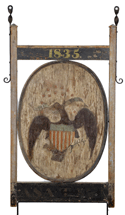|
Cowan's
Corner
Early American Tavern Signs:
The Original Roadside Billboards
By Wes Cowan
and Joe Moran
Samuel Johnson once said, "There is nothing which has yet been contrived by
man, by which so much happiness is produced as by a good tavern."
A glance
down Main Street of a typical 18th century New England town would reveal many
signs directing patrons and passers-by to the apothecary, the barber or the
saddler. Tavern signs, depicting iconographic patriotic eagles, prancing horses
and stoic bulls were usually the most eye-catching signs in town.
Because
taverns were usually the most popular meeting spots, their signs have always
held a special regard in history above other types of signs. A well-made sign
was considered a measure of an establishment's success, so tavern owners sought
out talented carpenters and sign painters. As a result, some of the most
talented artists of the day, such as Benjamin West and Hudson River School
founder Thomas Cole, took up the respectable profession of sign painting.
Competition caused innkeepers to make more and more elaborate signs that
projected farther and farther out into the street.
By the mid-18th century,
however, the profusion of signs became a nuisance as they began blocking light
and air circulation, and even causing casualties due to falling all of which
gave way to legislation. In both Paris and England in the 1760s, trade signs
were to be mounted flush against the building's walls, and only tavern and inn
signs were permitted to project into the public space. Similar legislation was
passed in the 1770s in Philadelphia restricting the use of signboards to tavern
keepers alone.
America's "Golden Age" of sign making occurred from the last
quarter of the 18th to the mid-19th century. The taverns became recognizable by
the mere presence of the double-sided swinging signboards or hanging bracket.
The signs primarily contained a large image and a few words. In the 1820s, due
to the advent of railroad transportation and the increased speed of travelers as
road conditions improved, many signs were changed from vertical to horizontal
formats. Subsequently, signs positioned vertically began to carry more verbiage
and less imagery.
White pine was the wood of choice for tavern signs. It was
plentiful, and the species grew to a large size. Pine was also easy to carve and
was very durable to the exterior elements. Linseed oil and shellac mixed with
calcium carbonate were used to increase the pine wood's tolerance to the
outdoors.
Many different kinds of wooden trade signs are available to
collectors. Unfortunately, the most well-made tavern signs are scarce, and many
are in private collections. Novice collectors should be forewarned that the date
on the tavern sign usually represents when the innkeeper received his license
not necessarily the date the sign was made. Heavily repainted signs are also
considered a negative.
One must acknowledge the charm contained in these
early tavern signs compared to today's modern billboard, "FOOD AND FUEL THREE
MILES AHEAD."
 Wes Cowan
is founder and owner of Cowan's Auctions, Inc. in Cincinnati, Ohio. An
internationally recognized expert in historic Americana, Wes stars in the PBS
television series History Detectives and is a featured appraiser on Antiques
Roadshow. He can be reached via email at info@historicmericana.com. Article
research by Joe Moran. Wes Cowan
is founder and owner of Cowan's Auctions, Inc. in Cincinnati, Ohio. An
internationally recognized expert in historic Americana, Wes stars in the PBS
television series History Detectives and is a featured appraiser on Antiques
Roadshow. He can be reached via email at info@historicmericana.com. Article
research by Joe Moran.
|

Cowan's Auctions sold this mid-19th c. American wood sign for $1,150.

This double-sided and dated tavern sign with U.S. eagle sold for $11,500 last
May. The sign came out of the Asa Taft Tavern in Massachusetts.

Pine board shoe repair sign with painted boots icons, $805.

Pine board drug store trade sign ca. 1900 with apothecary mortar and pestle
icons, $1,495. |